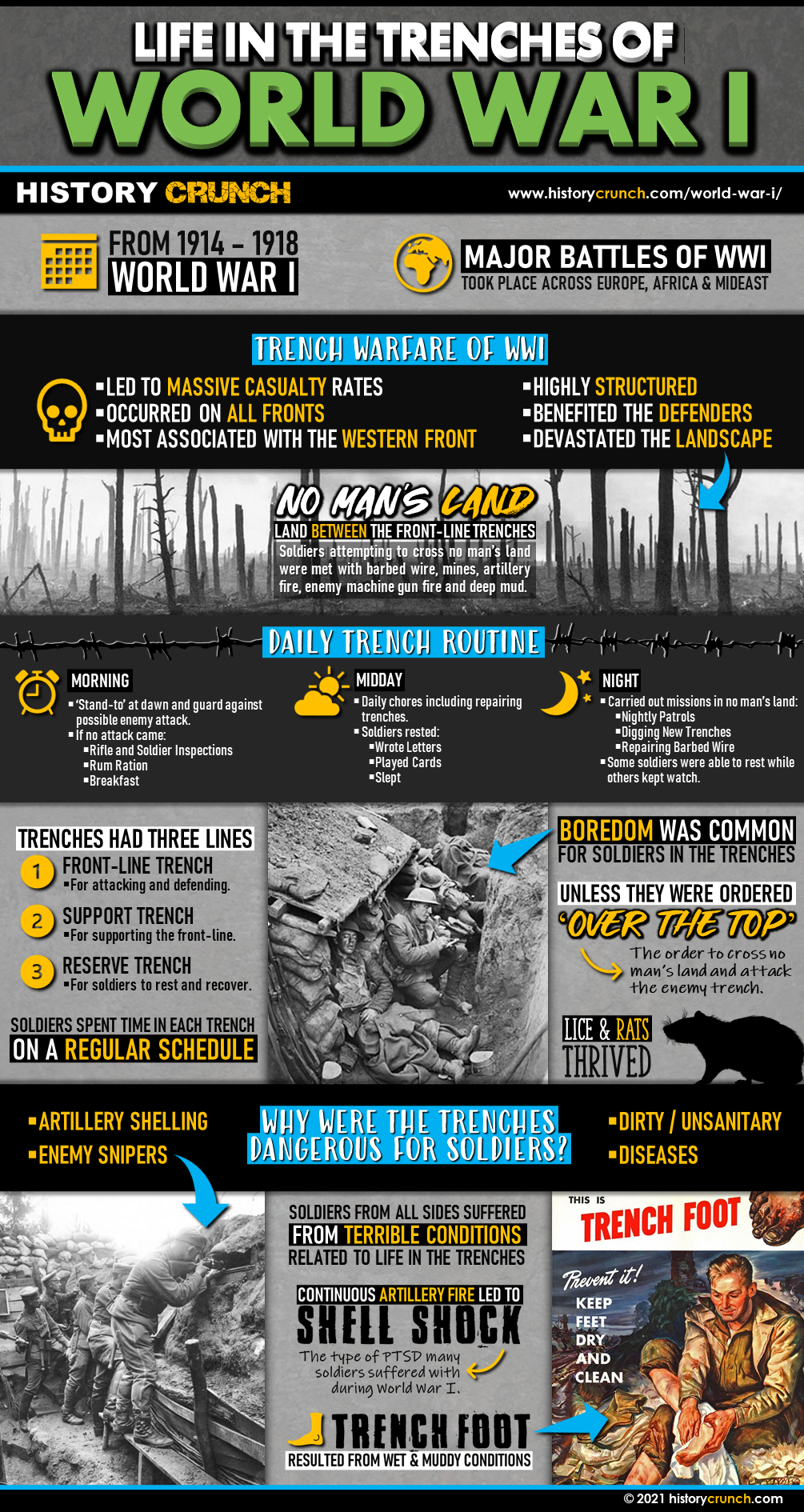Describe Life in the Trenches During Ww1
The familiar features of trench warfare such as barbed wire sandbags and dugouts. 630pm onwards - Work all night with some time for rest.

Life In The Trenches Of World War I History Crunch History Articles Biographies Infographics Resources And More
It has been estimated that at the height of the conflict.

. Life in the trenches. Trenches were long narrow ditches dug into the ground where soldiers lived. During WW1 the trenches were built to protect soldiers from bullets and guns.
Life in the trenches was difficult for the soldiers. In early 1916 life in the trenches was considered more comfortable by many Australian troops. They were infested with rats year-round and in the winter the trenches filled with mud and ice.
The soldiers of World War I lived through terrible conditions in the war including several key elements present in the trenches. Life in the Trenches. In the trenches those poor fighting men got up close and personal with death.
Up to 24 cash back Life in the trenches was never going to be easy and even in the chaos of battle the soldiers still had to follow a daily routine on top of keeping the enemy at bay. The combination of death and disease infiltrated every quarter. They were infested with rats all year round and in the winter the trenches filled with mud and ice.
Its universally accepted that life in the trenches during World War One was incredibly hard leaving many with physical and psychological injuries from which they would. On the Western Front the war was fought by soldiers in trenches. Aside from the risk of the attack from the enemy.
Although most of us think primarily of the Great War in terms of life and death in the trenches only a relatively small proportion of the army actually served there. Front of the trench is called the parapet and the rear is called the. They were very muddy uncomfortable and the toilets.
Life in the trenches proved to be a harrowing experience. Fenetrier trench life was similarly monotonous. Trench life involved long periods of boredom mixed with brief periods of terror.
7 feet deep and 6 feet wide. The soldiers were often cold and wet hungry. Trenches as tight boots wet conditions and cold caused foot swelling and pain.
Once the First World War begun the German army rushed through Belgium towards France where they were stopped by French and English. The trenches were the front. 630pm - Stand-down half an hour after dusk.
There were many dead bodies buried. On This Day - 100 Years Ago - 12th October 1914. For instance life in the trenches of World War I was.
Our life was this. The dirtiness of the trenches attracted different pests like rats lice frogs and many others. During the First World War it dramatically changed with the advances by the Germans through Belgium and France in route for Paris.
Life in the trenches of World War I was an important aspect of the First World War. Frogs by the score were found in shell holes covered in. Life in the trenches was difficult for the soldiers.
Rats would eat the soldiers food and would also eat the soldiers while they were. History says Life in the trenches offered about the worst conditions one could imagine. Up to 24 cash back LIFE IN THE TRENCHES.
The threat of death kept soldiers constantly on edge while poor living conditions and a lack of sleep wore. Life in the Trenches. Construction of a trench.
Lice were not actually identified as the culprit of Trench Fever until 1918. There were all sorts of pests living in the trenches including rats lice and frogs. The soldiers were often cold and wet hungry.
Life in the trenches was often said to be hell on earth and nobody who went there argued to the contrary. For those who had served on Gallipoli the conditions on the Western Front. The trenches could be very muddy.
British soldiers in a trench during World War I. The closest trench to the enemy. For French NCO G.
When we think about the life of the soldiers who fought in World War I we usually think about soldiers firing from the trenches and. The rats were everywhere and got into the soldiers food and ate just about everything including sleeping. Recovery - away from the trenches - took up to twelve weeks.
LIFE IN THE TRENCHES LETTERS HOME 2 Trench Foot Symptoms blisters blotchy skin redness. From the beginning of the day until the night we were eating sometimes some bread chocolate.

Life In The Trenches Of World War I History Crunch History Articles Biographies Infographics Resources And More

Trench Life During Wwi While In The Trenches Last Week John By Hannah Knechel Medium
Life In The Trenches Of The First World War The Long Long Trail

Top 10 Facts About The Trenches Fun Kids The Uk S Children S Radio Station
No comments for "Describe Life in the Trenches During Ww1"
Post a Comment